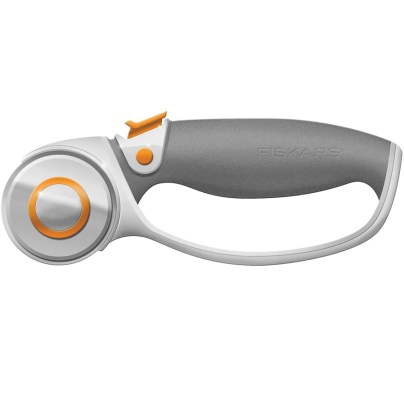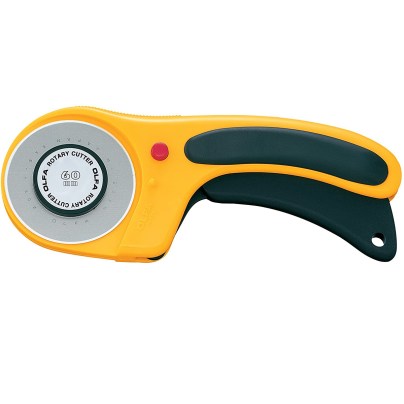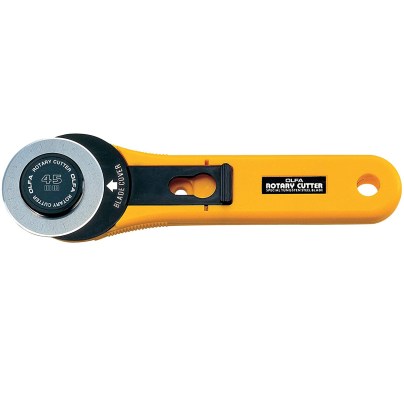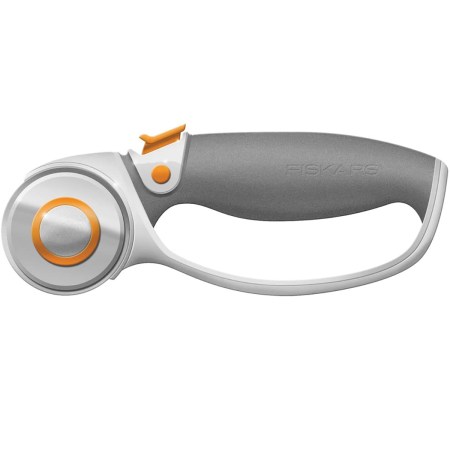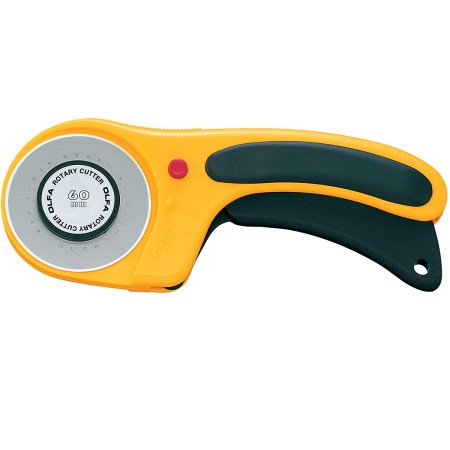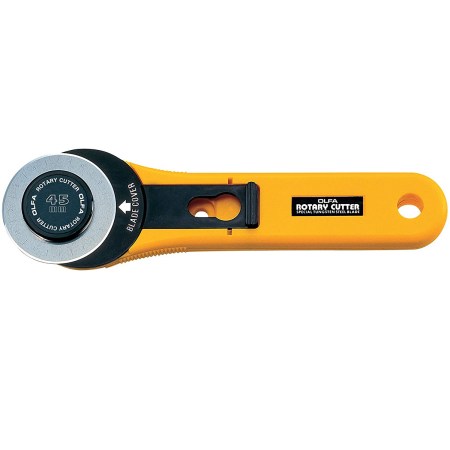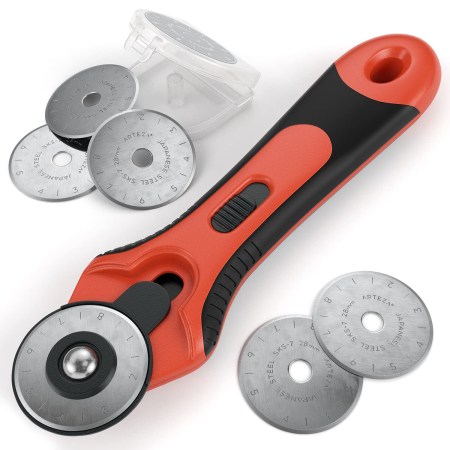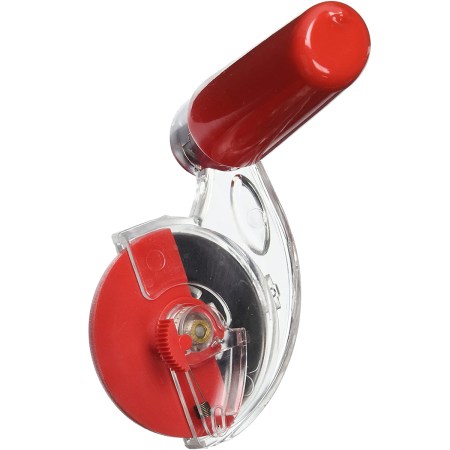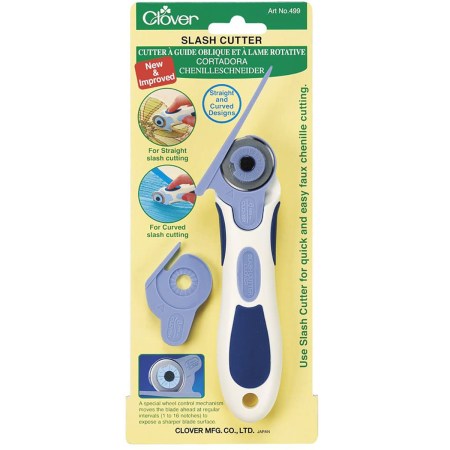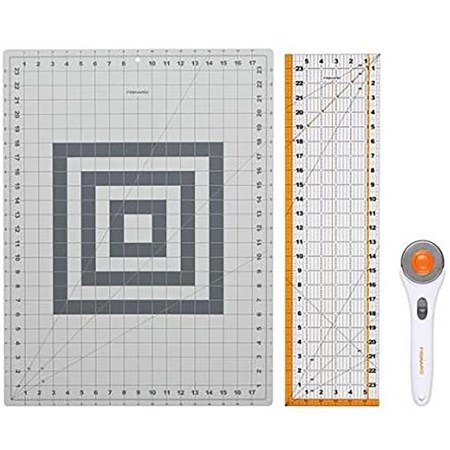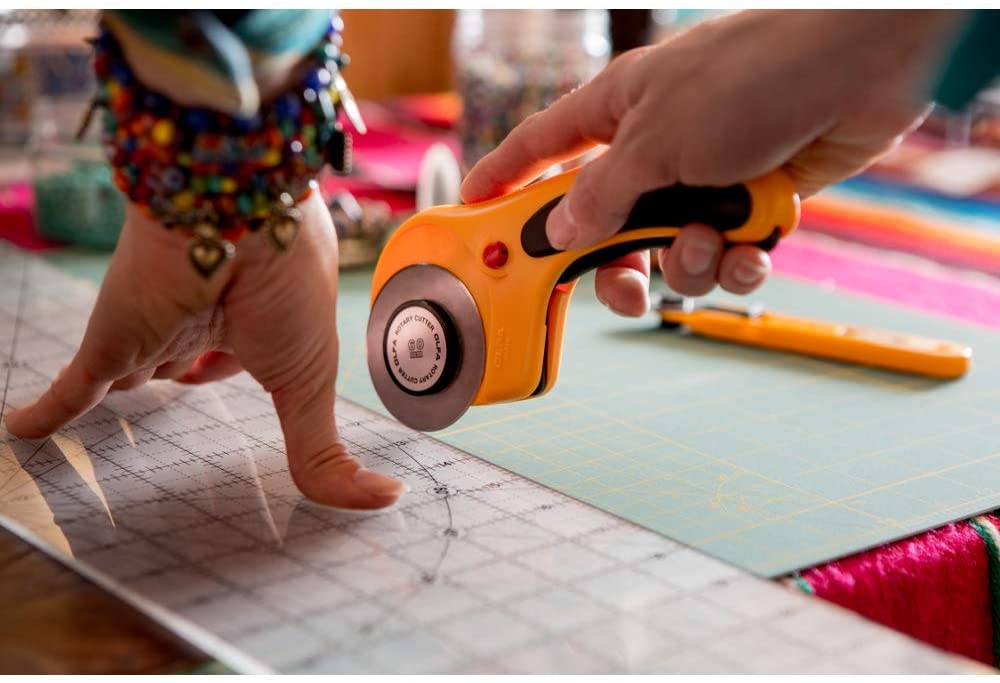
We may earn revenue from the products available on this page and participate in affiliate programs. Learn More ›
A high-quality store-bought quilt can bring beauty and comfort to any bedroom, but there’s something very special about one that has been handcrafted. Quilting is just one of many fabric crafts for which a rotary cutter is invaluable.
A good pair of scissors is great for tight curves and detailed cutouts, but when it comes to cutting through yards of material in preparation for the sewing machine, a rotary cutter is undoubtedly the tool of choice. This versatile item is not just for quilting, and it comes in a range of sizes and styles to suit many different tasks. This guide explores several of the most important factors to consider when choosing the best rotary cutter for your DIY projects and reviews some of the top-rated products on the market today.
- BEST OVERALL: Fiskars 01-005874 Titanium Softgrip Comfort Loop
- RUNNER-UP: Olfa Deluxe Rotary Cutter (60mm)
- BEST BANG FOR THE BUCK: OLFA Rotary Cutter RTY-2/G
- BEST SMALL: ARTEZA 28 mm Quilting Rotary Cutter
- BEST ERGONOMIC: Martelli Ergo 2000 45mm Rotary Cutter
- BEST SLASH/CHENILLE: CLOVER Slash Cutter
- BEST ROTARY CUTTER KIT: Fiskars Crafts 952301010 Rotary Sewing Cutting Set
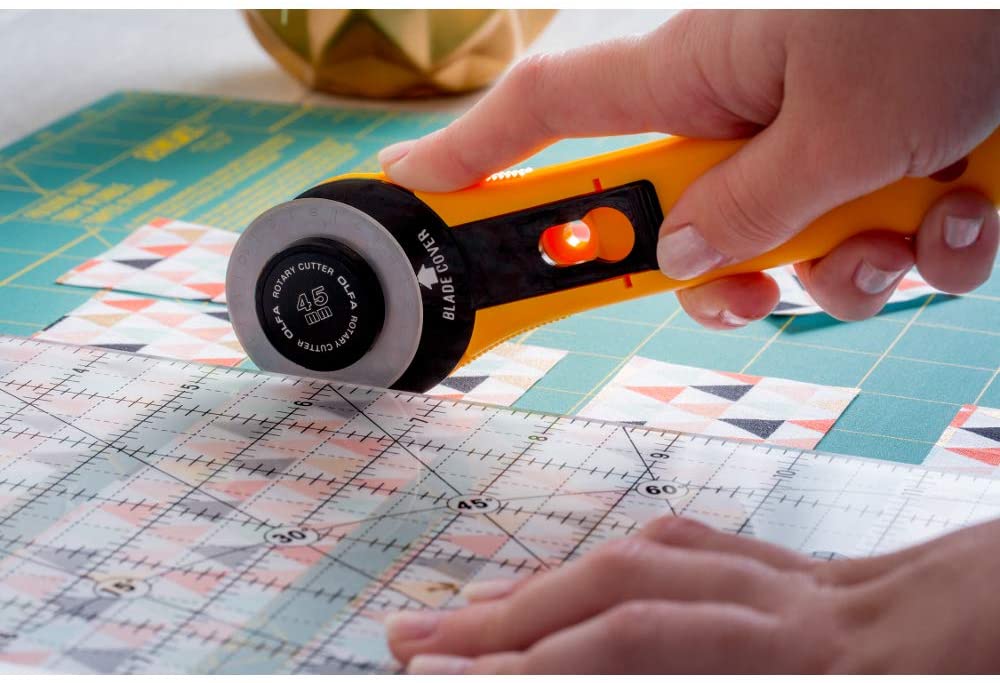
What to Consider When Choosing the Best Rotary Cutter
The following section takes an in-depth look at the range of available features, covering both technical aspects and practical applications. Reading through it will provide a thorough understanding of these tools and make it easier to choose the best rotary cutter for your needs when you are ready to buy.
Blade Size
Rotary cutters are usually specified by their blade diameter. There are four common models: 18 millimeter, 28 millimeter, 45 millimeter, and 60 millimeter.
- An 18 millimeter rotary cutter is good for small, detailed cuts and for cutting curves.
- A 28 millimeter model won’t cut quite as fine a detail, but it will slice through several layers.
- A 45 millimeter cutter is perhaps the most popular and versatile option. It is still relatively maneuverable and capable of cutting through many layers of material at the same time. This model is generally suggested as the one for beginners.
- A 60 millimeter cutter is preferable for cutting many yards of fabric or for thicker materials, like heavy cotton or leather. Since the cutting edge is longer, the blade won’t need to be sharpened or replaced as often as other models.
Blade Type and Material
Along with the standard straight-cutting blade, there are several useful variations:
- Pinking blades are perhaps the most common alternative, creating the same edge as pinking shears to help prevent the fraying of fabric.
- Scallop and wavy blades create decorative edges on fabrics or for paper crafts.
- Slash cut/chenille blades create straight or wavy cuts close together and frequently include a spacing guide.
- Skip-cut blades are designed to punch a row of holes along fabric edges to add an embroidered or crocheted finish.
Blades are usually made of a combination of stainless steel and tungsten. They don’t rust, are very hard, and offer good edge retention. Titanium-coated blades, often gold in color, can be even sharper and more durable. However, they typically cost more.
Comfort and Safety Features
Rotary cutters are primarily available in three designs. All shield the blade to some extent when not in use.
The most basic design, sometimes called a stick cutter, has a plain handle with a button to slide the cutting wheel into position. These are perfectly workable but not usually ergonomically designed for long-term use.
The second design features a squeeze (or trigger) grip. Many users find it offers a more natural, knife-like holding position. As you squeeze the handle, the blade descends. This offers additional safety; as soon as you let go, the blade is shielded again.
The third design provides a similar knife-like hold but offers a thicker grip and a loop (finger guard). A slider on the back moves the blade forward for cutting, and a lock may hold it in place. This is arguably the most comfortable design, though it may not suit those with larger hands.
Accessories
A variety of handy accessories can enhance the use of the best rotary cutter. First, never underestimate the value of a good sewing table. While it might seem like an extravagance, a sewing table provides a comfortable work height and a dedicated place to store materials and tools.
A self-healing cutting mat is also a great investment. It features a convenient grid for alignment purposes with a surface designed to make cutting cleaner and easier. A cutting mat also maximizes blade life and can provide years of use, even with heavy cutting.
You may also want to consider a collection of clear acrylic quilting rulers that lay on top of pieces of fabric, allowing you to still see the pattern through them. They feature square and diagonal grids to help you cut exactly where desired.
Our Top Picks
You should now have a good idea of the key features to consider when choosing the best rotary cutter, so it’s time to start shopping. Read on to discover some of the top-rated options for DIY projects in a variety of categories.
Best Overall
Fiskars 01-005874 Titanium Softgrip Comfort Loop
This outstanding rotary cutter from Fiskars has tremendous appeal. It is both high quality and very competitively priced. The 45-millimeter size is a favorite with many sewers and crafters, as it combines maneuverability with good depth of cut. The supersharp titanium-coated blade is harder than tungsten carbide variants, so it provides better edge retention. It can be fitted to either side of the handle, meaning this rotary cutter is suitable for both right- and left-handed users.
A thumb control slides the blade away from the safety shield and into position. It can be locked in place or left to retract when each cut is finished. The soft grip helps reduce hand fatigue when working for long periods. The loop is designed to feel natural and improves control. However, those with particularly large hands may not find this rotary cutter quite so comfortable.
Runner-Up
Olfa Deluxe Rotary Cutter (60mm)
OLFA’s 60-millimeter rotary cutter is designed for those who frequently need to cut through multiple layers or tougher materials, like leather, that need greater force. The handle is curved to keep the wrist in a natural position during each cut. Raised inserts provide for both control and comfort.
A gentle squeeze of the trigger beneath the handle extends the tungsten carbide blade, which retracts for safety when not in use. The blade assembly is reversible, allowing for ambidextrous use. While more expensive than many other options, this is a high-quality tool and can tackle anything from lightweight fabrics to challenging cutting tasks, like suede, rubber, and even Kevlar.
Best Bang For the Buck
OLFA Rotary Cutter RTY-2/G
OLFA’s straight-handled 45-millimeter rotary cutter may be quite basic and budget-friendly, but it is all many crafters will need. This tool is designed for right- or left-handed users with a tungsten carbide blade that minimizes cutting effort. Fingertip grips provide added control.
On this model, the cover retracts instead of the blade. It isn’t automatic, however, so care is required not to leave the blade exposed. This low-cost Olfa cutter is well made, durable, and a great value for money. A drawback is that this type of rotary cutter isn’t the most ergonomic, which can lead to discomfort during extended use.
Best Small
ARTEZA 28 mm Quilting Rotary Cutter
The Arteza rotary cutter features a 28-millimeter blade that’s great for detail work. It’s made from Japanese SKS-7 tungsten alloy tool steel, which claims to maintain a keen edge much longer than many competitors. The ergonomic handle features soft grip inserts for improved hand comfort, and the blade guard provides a useful safety lock.
The reversible design means the Arteza rotary cutter is equally suitable for both right- and left-handed users. Six replacement blades are included with the purchase, making the price even more competitive. However, while this is a good tool for light-duty work, it is not ideal for consistent heavy cutting, given its size.
Best Ergonomic
Martelli Ergo 2000 45mm Rotary Cutter
Unlike most rotary cutters, the precision-engineered Martelli Ergo boasts a large, rounded handle set at a 90-degree angle to the cutter. This design both improves control and makes it easier to use, particularly for those with issues like arthritis, carpal tunnel syndrome, or tendinitis. Additionally, a spring-loaded blade guard flips back into place when the cutter is not in use.
This cutter is available in 45 millimeter and 60-millimeter models for medium to heavy-duty cutting. The Martelli Ergo is not ambidextrous, so choose either a right- or left-handed model when making a purchase.
Best Slash/Chenille
CLOVER Slash Cutter
Strictly speaking, this budget-friendly Clover tool is not a rotary cutter. Unlike the normal rolling action of a rotary cutter, the blade turns in increments to present a fresh cutting edge for each slice. Not only is this functionality more efficient, but it also offers great precision for repetitive cutting. This is especially true when using a ruler or a cutting mat is not practical.
Two guides are included with purchase: one for straight cuts and one for curves. Their width makes it easy to maintain consistency. The Clover slash cutter can be used right- or left-handed and features soft-grip areas for hand comfort. While this tool is something of a specialty device, many find the handle makes it easier to control than alternatives that need to be held between the fingertips.
Best Rotary Cutter Kit
Fiskars Crafts 952301010 Rotary Sewing Cutting Set
The Fiskars Rotary Cutting Set is hugely popular for a very good reason: It offers everything the beginner needs to start crafting. The rotary cutter itself is a classic stick design with a 45-millimeter blade that’s great for general-purpose cutting of both fabrics and paper. A button slides the blade into position and retracts it within the guard when not in use.
This competitively priced set also includes an 18-inch by 24-inch self-healing cutting mat, marked with a measuring grid that’s invaluable for accuracy. This is accompanied by a clear acrylic ruler to easily visualize the fabric or paper. Fiskars also offers alternative sets made to the same high quality for those whose focus is on home decor, garment making, and quilting.
FAQs About Rotary Cutters
Having read about the features to consider when shopping for the best rotary cutters as well as reviewing the selection of top picks, you should now be better informed about the benefits of these versatile craft tools. However, you may still have one or two questions. The following are those that crop up most often.
Q. What can you cut with a rotary cutter?
You can cut a wide variety of fabrics with a rotary cutter, including leather and other hides, in addition to rubber and synthetic materials. They are also useful for papercrafts.
Q. What size rotary cutter do I need?
It largely depends on the type of materials you cut and the accuracy you need. A smaller cutter is typically more suited to performing detailed cuts and slicing through a few layers of materials, while larger cutters can handle tougher materials and thicker layers.
Q. Can rotary cutter blades be sharpened?
Yes. You can buy both manual and electric sharpeners that will extend the life of the blades.
Q. Why is my rotary cutter not cutting?
If it’s not cutting in a particular area, the blade could be damaged. However, all blades eventually become dull and will need to be either sharpened or changed. Fortunately, quality replacements are not expensive.
